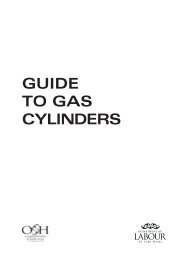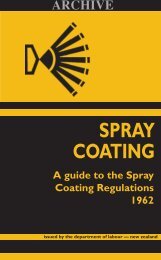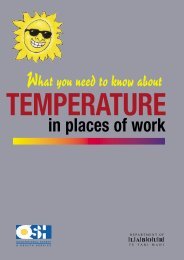Underground Petroleum Storage Tanks and Related Wastes - Code ...
Underground Petroleum Storage Tanks and Related Wastes - Code ...
Underground Petroleum Storage Tanks and Related Wastes - Code ...
Create successful ePaper yourself
Turn your PDF publications into a flip-book with our unique Google optimized e-Paper software.
- Transit insurance — the load (i.e. tanks) are not considered part of the<br />
vehicle <strong>and</strong> provision should be made for any liability which the load<br />
itself could cause.<br />
- Because of the hazardous nature of the load, the insurance company<br />
should be advised of this to ensure full disclosure had been made.<br />
Otherwise the insurance company may decline liability.<br />
• Copies of insurance cover to be made available to the principal.<br />
15. RECOMMENDED EQUIPMENT CHECKLIST FOR TANK DISPOSAL<br />
15.1 Disposal Pad <strong>and</strong> Separator<br />
Minimum requirements are:<br />
• A concrete or similarly impervious floor large enough to hold the largest<br />
tank to be treated, <strong>and</strong> to containing contaminated drainings.<br />
- Well sealed at any construction joints to prevent escape of any<br />
contamination into the ground.<br />
- Located at least 15 metres from any source of ignition.<br />
• A suitable separator/recycling facility to allow water, sludge <strong>and</strong> product<br />
separation, <strong>and</strong> product draw off.<br />
• Holding tanks for waste product <strong>and</strong> sludge.<br />
• Suitable pumps that do not constitute a source of ignition for removing<br />
waste product <strong>and</strong> waste sludge.<br />
15.2 Hazardous <strong>Tanks</strong> <strong>Storage</strong> Area<br />
To be 15 metres from the disposal pad <strong>and</strong> any source of ignition, or any areas to<br />
which the public has access or any adjacent areas not under the direct control of<br />
the contractor where hot work may be carried out. To be well clear of the line of<br />
the axis of any tank st<strong>and</strong>ing on the disposal pad ready for cutting (to avoid impact<br />
should a tank end blow out during cutting).<br />
15.3 Hot <strong>and</strong> Cold Cufflng Equipment<br />
Plasma cutter <strong>and</strong>/or oxygen/acetylene cutting equipment<br />
Pneumatically-operated nibbler<br />
Pneumatically-operated drill<br />
Air compressor of adequate capacity<br />
Air extractor pneumatically driven<br />
Air blower with EXD motor or air drive.<br />
15.4 Cleaning Equipment<br />
Steam generator <strong>and</strong> cleaner, or<br />
Water blast equipment<br />
Adequate supply of clean water<br />
Flame cleaning or grit/shot blasting equipment.<br />
Transport <strong>and</strong> Disposal of <strong>Petroleum</strong> <strong>Storage</strong> <strong>Tanks</strong> 27





